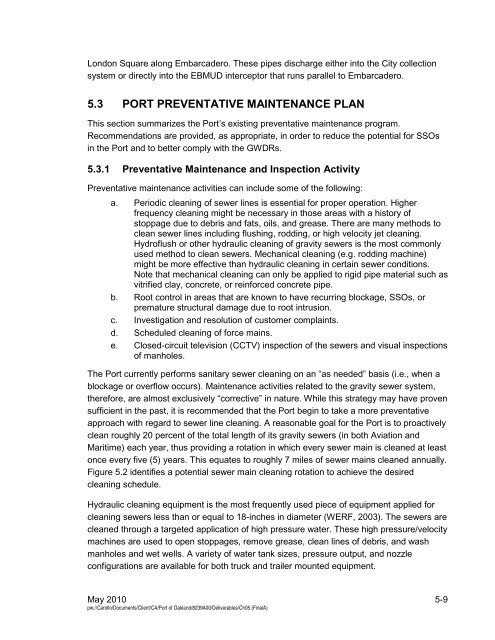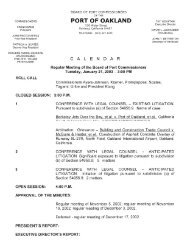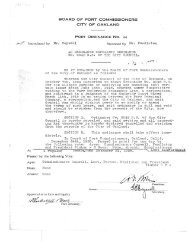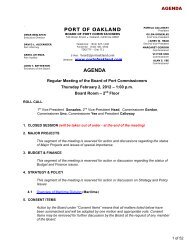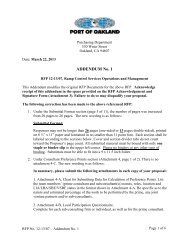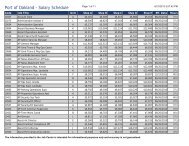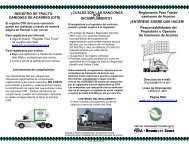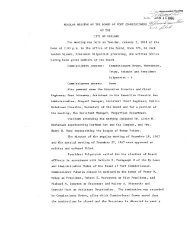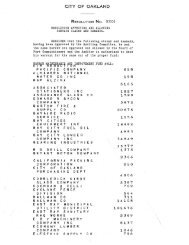Port-Wide Sewer System Management Plan(SSMP) - Port of Oakland
Port-Wide Sewer System Management Plan(SSMP) - Port of Oakland
Port-Wide Sewer System Management Plan(SSMP) - Port of Oakland
Create successful ePaper yourself
Turn your PDF publications into a flip-book with our unique Google optimized e-Paper software.
London Square along Embarcadero. These pipes discharge either into the City collection<br />
system or directly into the EBMUD interceptor that runs parallel to Embarcadero.<br />
5.3 PORT PREVENTATIVE MAINTENANCE PLAN<br />
This section summarizes the <strong>Port</strong>’s existing preventative maintenance program.<br />
Recommendations are provided, as appropriate, in order to reduce the potential for SSOs<br />
in the <strong>Port</strong> and to better comply with the GWDRs.<br />
5.3.1 Preventative Maintenance and Inspection Activity<br />
Preventative maintenance activities can include some <strong>of</strong> the following:<br />
a. Periodic cleaning <strong>of</strong> sewer lines is essential for proper operation. Higher<br />
frequency cleaning might be necessary in those areas with a history <strong>of</strong><br />
stoppage due to debris and fats, oils, and grease. There are many methods to<br />
clean sewer lines including flushing, rodding, or high velocity jet cleaning.<br />
Hydr<strong>of</strong>lush or other hydraulic cleaning <strong>of</strong> gravity sewers is the most commonly<br />
used method to clean sewers. Mechanical cleaning (e.g. rodding machine)<br />
might be more effective than hydraulic cleaning in certain sewer conditions.<br />
Note that mechanical cleaning can only be applied to rigid pipe material such as<br />
vitrified clay, concrete, or reinforced concrete pipe.<br />
b. Root control in areas that are known to have recurring blockage, SSOs, or<br />
premature structural damage due to root intrusion.<br />
c. Investigation and resolution <strong>of</strong> customer complaints.<br />
d. Scheduled cleaning <strong>of</strong> force mains.<br />
e. Closed-circuit television (CCTV) inspection <strong>of</strong> the sewers and visual inspections<br />
<strong>of</strong> manholes.<br />
The <strong>Port</strong> currently performs sanitary sewer cleaning on an “as needed” basis (i.e., when a<br />
blockage or overflow occurs). Maintenance activities related to the gravity sewer system,<br />
therefore, are almost exclusively “corrective” in nature. While this strategy may have proven<br />
sufficient in the past, it is recommended that the <strong>Port</strong> begin to take a more preventative<br />
approach with regard to sewer line cleaning. A reasonable goal for the <strong>Port</strong> is to proactively<br />
clean roughly 20 percent <strong>of</strong> the total length <strong>of</strong> its gravity sewers (in both Aviation and<br />
Maritime) each year, thus providing a rotation in which every sewer main is cleaned at least<br />
once every five (5) years. This equates to roughly 7 miles <strong>of</strong> sewer mains cleaned annually.<br />
Figure 5.2 identifies a potential sewer main cleaning rotation to achieve the desired<br />
cleaning schedule.<br />
Hydraulic cleaning equipment is the most frequently used piece <strong>of</strong> equipment applied for<br />
cleaning sewers less than or equal to 18-inches in diameter (WERF, 2003). The sewers are<br />
cleaned through a targeted application <strong>of</strong> high pressure water. These high pressure/velocity<br />
machines are used to open stoppages, remove grease, clean lines <strong>of</strong> debris, and wash<br />
manholes and wet wells. A variety <strong>of</strong> water tank sizes, pressure output, and nozzle<br />
configurations are available for both truck and trailer mounted equipment.<br />
May 2010 5-9<br />
pw://Carollo/Documents/Client/CA/<strong>Port</strong> <strong>of</strong> <strong>Oakland</strong>/8239A00/Deliverables/Ch05 (FinalA)


